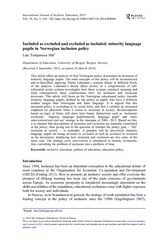| dc.contributor.author | Hilt, Line | |
| dc.date.accessioned | 2014-06-02T10:55:20Z | en_US |
| dc.date.accessioned | 2014-11-11T09:24:34Z | en_US |
| dc.date.accessioned | 2014-12-10T09:41:07Z | |
| dc.date.available | 2014-12-10T09:41:07Z | |
| dc.date.issued | 2014-05-13 | eng |
| dc.identifier.issn | 1360-3116 | |
| dc.identifier.uri | https://hdl.handle.net/1956/8876 | |
| dc.description.abstract | This article offers an analysis of four Norwegian policy documents on inclusion of minority language pupils. The main concepts of this policy will be reconstructed and re-described, applying Niklas Luhmann's systems theory at different levels of the analysis. Luhmann's theory about society as a conglomerate of self-referential social systems investigates how these systems construct meaning and what consequences these constructions have for inclusion and exclusion processes. This article will focus on the Norwegian educational policy towards minority language pupils, defined by the policy as pupils who have a different mother tongue than Norwegian and Sami language. It is argued that this inclusion policy is excluding in its social form, and that it exhibits an increased emphasis on education when it comes to inclusion in society. Re-descriptions based on logic of forms will show how binary distinctions such as ‘inclusion/exclusion', ‘majority language pupil/minority language pupil' and ‘early intervention/wait and see' emerge in the timespan of 2004–2012. Based on this, it is claimed that descriptions of inclusion and exclusion are mutually constituted in the policy, thus giving rise to the question of whether the policy goal – ‘full' inclusion in society – is realisable. A paradox will be uncovered: minority language pupils are being included as excluded as well as excluded as included in the documents, displaying how inclusion and exclusion are two sides of the same coin. The strategy early intervention is introduced to remedy exclusions, thus converting the problem of inclusion into a problem of time. | en_US |
| dc.language.iso | eng | eng |
| dc.publisher | Routledge | eng |
| dc.relation.ispartof | <a href="http://hdl.handle.net/1956/12692" target="blank">The Borderlands of Educational Inclusion. Analyses of inclusion and exclusion processes for minority language students</a> | |
| dc.rights | Attribution CC BY | eng |
| dc.rights.uri | http://creativecommons.org/licenses/by/3.0 | eng |
| dc.subject | inclusive education | eng |
| dc.subject | politics of education | eng |
| dc.subject | education policy | eng |
| dc.title | Included as excluded and excluded as included: minority language pupils in Norwegian inclusion policy | eng |
| dc.type | Peer reviewed | |
| dc.type | Journal article | |
| dc.date.updated | 2014-06-02T10:55:20Z | en_US |
| dc.description.version | publishedVersion | |
| dc.rights.holder | Copyright 2014 The Authors | |
| dc.identifier.doi | https://doi.org/10.1080/13603116.2014.908966 | |
| dc.identifier.cristin | 1133065 | |
| dc.source.journal | International Journal of Inclusive Education | |
| dc.source.40 | 19 | |
| dc.source.14 | 2 | |
| dc.source.pagenumber | 165-182 | |

